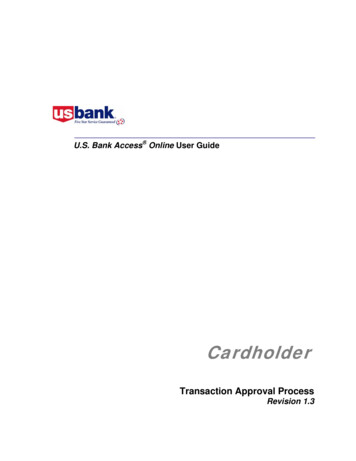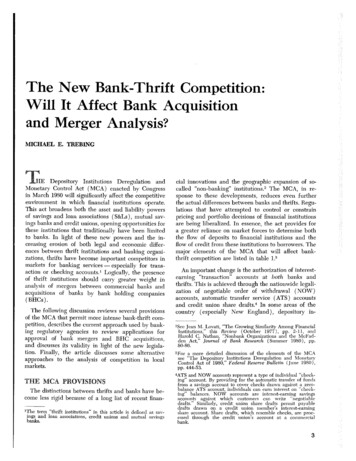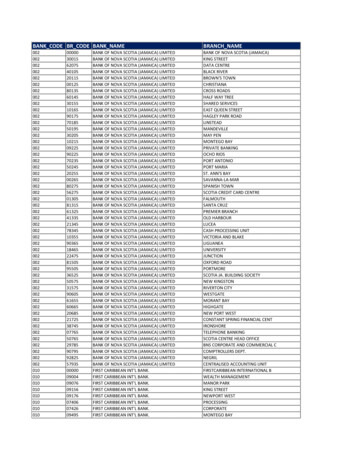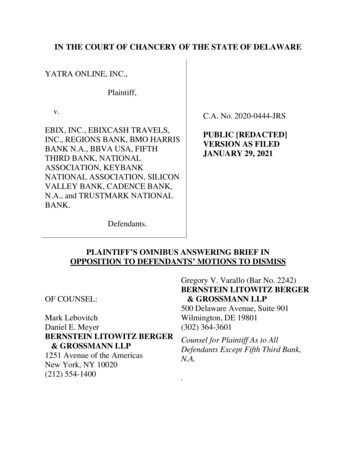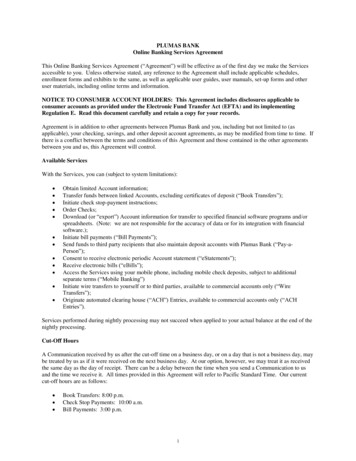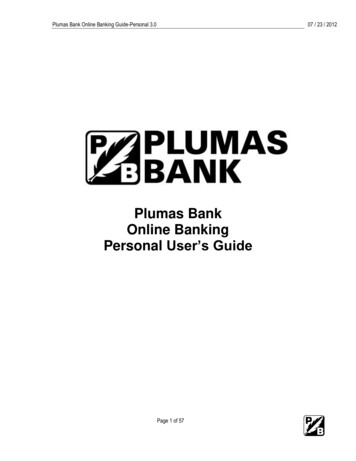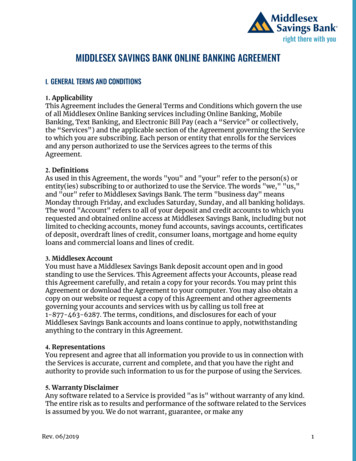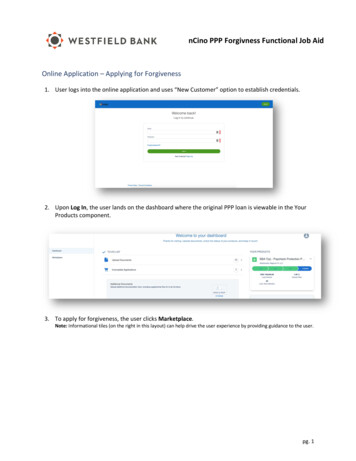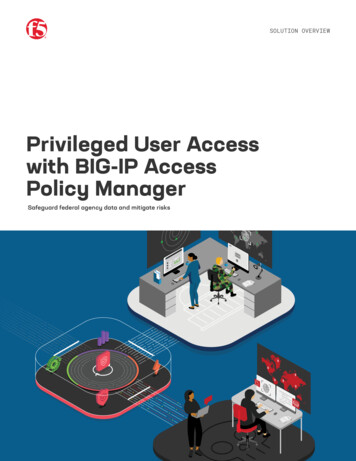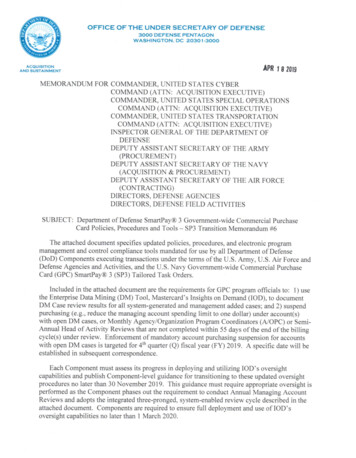
Transcription
Department of Defense SmartPay 3Government-wide Commercial Purchase CardPolicies, Procedures and ToolsReferences(A) SmartPay 3 (SP3) GPC System Summary Functional ay3 TI and PCET.html(B) Joint Appointments Module (JAM) GPC Role artPay3 TI and PCET.html(C) Procurement Integrated Enterprise Environment (PIEE) Procure to Pay (P2P)Capability Summaryhttps://www.acq.osd.mil/dpap/pdi/p2p/p2p capability summaries.html(D) GPC JAM ay3 TI and PCET.html(E) DoD High-Risk Merchant Category Code (MCC) List (FOUO – CAC Pay3 TI and PCET.html(F) DoD Government Charge Card Guidebook for Establishing and Managing Purchase,Travel, and Fuel Card Programs, Release Dated 14 November 2018, incorporatedinto the Defense Federal Acquisition Regulation Supplement (DFARS) at icy documents.html(G) AxOL Enterprise Purchase Log Requirements (FOUO – CAC Pay3 TI and PCET.html(H) U.S. Bank Access Online Order Management User Guide available through U.S.Bank Web-Based Traininghttps://wbt.access.usbank.com/login(I) Monthly A/OPC and Semi-Annual HA Review Reports—Format, Data Sources, andCalculation martPay3 TI and PCET.htmlThis document specifies updated policies, procedures, and electronic program management andcontrol compliance tools mandated for use by all Department of Defense (DoD) Componentsexecuting transactions under the terms of the U.S. Army, U.S. Air Force and Defense Agenciesand Activities (A/AF/DA), and the U.S. Navy (USN) SP3 Government-wide CommercialPurchase Card (GPC) SmartPay 3 (SP3) Tailored Task Orders (TTOs).I. Purchase Card Program OversightDepartment of Defense (DoD) Instruction 5010.40, “Managers’ Internal Control ProgramProcedures,” 30 May 2013, requires DoD organizations to implement a comprehensive system ofinternal controls that provides reasonable assurance that programs are operating as intended andto evaluate the effectiveness of the controls.1
Oversight is conducted to: Validate and promote compliance with existing purchasing and management internalcontrolsIdentify, report on and resolve systemic material program weaknessesMeasure the effectiveness of purchasing and management internal controls.To improve auditability of GPC program oversight and to realize the cost and other benefits ofutilizing the commercially available technology offered under the SP3 arrangements, DoD willmove during fiscal years (FYs) 2019 and 2020 from the distributed Annual Managing AccountReview process utilized during SP2 to the integrated three-pronged, system-enabled review cycledepicted in Table I-1.GPC SP3 Program Oversight CycleTable I-1The GPC Daily, Monthly and Semi-Annual review cycle (GPC Review Cycle) supplementsexisting GPC monthly operational transaction management and account reconciliation andreview processes that include: Cardholder obtained purchasing pre-approvals (e.g., Approving/Billing Official (A/BO)pre-purchase approval, special item approval, availability of appropriate and sufficientfunds)Cardholder created Purchase Log and Statement of Account approval 1 (includes 100percent of transactions)A/BO Managing Account Monthly Review and Billing Statement approval 2 (includes100 percent of transactions)1Includes attesting to DoD Financial Management Regulation (FMR) Volume 10 Chapter 23, Figure 23-2,“Purchase Card Certification Statements.”2Ibid.2
Certifying Officer 3 Monthly Review and Managing Account Billing Statementcertification (i.e., Invoice Certification 4) (includes 100 percent of transactions)Resource Manager/Financial Management funds certificationAgency/Organization Program Coordinator (A/OPC) ongoing purchasing and policycompliance effortsDisbursing Office funds validation and disbursement processing.The GPC Review Cycle will also supplement and inform both the periodic reviews ofComponent procurement offices (e.g., Service or Defense Contract Management Agencyconducted Procurement Management Reviews) that are conducted to assess the effectiveness ofthe contracting function, and the GPC governance processes that are conducted to evaluate andimprove the effectiveness of GPC purchasing and management internal controls.II. SP3 Mandatory Electronic ToolsIn order to facilitate appropriate user access to accurate and complete data for use in managingthe DoD GPC program, use of the following enterprise electronic tools by DoD Componentsexecuting transactions under the terms of the A/AF/DA and USN SP3 GPC TTOs is mandatedduring the SP3 transactional period. Reference A depicts the SP3 GPC System SummaryFunctional Workflow. Requests for waivers from the requirement to use any of these systemsmust be submitted through the Component’s acquisition chain of command to the AgencyProgram Management Office.A. Procurement Integrated Enterprise Environment (PIEE)Requirement: GPC Program Participants, as specified in Reference B, are requiredto register for a PIEE account and request the GPC role(s) appropriate for theirprogram function(s).PIEE is a procurement portfolio capability that uses a Common Access Card (CAC) enabledsingle-sign-on capability to grant access to system modules (e.g., Electronic Document Accessand Joint Appointment Module (JAM)) that are hosted both internal and external to thatenvironment. However, on an exception basis user name and password access to PIEE byGovernment employees (in lieu of CAC access) can be authorized. PIEE reduces DoD operatingcosts (e.g., by facilitating rapid development and deployment of modules and providing commonservices such as testing, archive retention, security), and improves the quality of, and access to,enterprise-wide data (e.g., by leveraging cloud technology and drawing data from multiplemodules into a single data set for use across the platform).PIEE utilizes the cross-functional (i.e., financial, procurement and logistics), Department ofDefense Activity Address Code (DoDAAC)-based hierarchies established by the Components tofacilitate PIEE account management and access routing, and to aggregate data at each node (e.g.,Army Contracting Command - Redstone Arsenal, Alabama) and/or Group Path (e.g., Departmentof Navy) for the hierarchy.3When Confirm and Pay procedures are used, the same individual serves as both the A/BO and the CertifyingOfficer.4Includes attesting to DoD Financial Management Regulation (FMR) Volume 10 Chapter 23, Figure 23-2,“Purchase Card Certification Statements.”3
The SP3 DoD TTOs require U.S. Bank to:i.ii.iii.maintain a crosswalk of the organization’s GPC TBR hierarchy, which is theprimary data key used by the bank, to the established PIEE DoDAAC-basedhierarchy;allow for the reporting of GPC account and transaction data using both the PIEEand TBR hierarchies; andaccept PIEE-authenticated GPC users and grant them single-sign-on access to U.S.Bank’s Electronic Access System, Access Online (AxOL).Additional information about PIEE is available in Reference C.B. JAMJAM is the PIEE module used to initiate, review, approve, store and terminate requireddelegations of procurement authority and/or appointments. As appropriate, JAM GPCappointments result in issuance of not only GPC Delegation and/or Appointment letters, but alsolimited-scope SF-1402 Certificate of Appointment (commonly referred to as a Warrant) and DDForm 577 Appointment/Termination Record – Authorized Signature (commonly referred to as aCertifying Officer Appointment). Additional JAM information is available in References B andD.Requirement: Electronic GPC Delegation of Authority and/or Appointment Lettersmust be granted for the GPC program participants as indicated in Reference B.C. AxOLAxOL is U.S. Bank’s internet-based system that provides account access and a variety of reportsto assist users in effectively managing their charge card programs.Requirement: Use of AxOL is required for:(1) A/OPCs to issue and maintain GPC accounts and manage their programs.JAM appointment data will be provided to AxOL via a system interface (plannedfor 2nd quarter FY 2020). A/OPCs will access AxOL and link issued JAMappointments to the appropriate Cardholder or Managing Account. Purchasinglimits authorized in JAM appointments will serve as the ceiling for AxOLauthorizations. The A/OPC will enter other purchasing limitations, such asMerchant Category Codes directly into AxOL.(2) Resource Managers to provide funding and valid Lines of Accounting for GPCaccounts.(3) Cardholders to create their purchase log (Order Management), documentsupply and service acceptance (Order Management – Order Receipt function),retain their transaction supporting documentation (Transaction Management Attachments) and approve GPC Statements of Account (Management).a. Cardholders shall not load any documents with a marking of “For OfficialUse Only” or higher to AxOL. Supporting documentation with thesemarkings shall be handled in accordance with applicable component4
requirements and be available off-line for purposes of account inspectionsand audits.(4) A/BOs to support their transaction compliance review process (e.g., reviewtransaction supporting data) and approve GPC Statements of Account(Transaction Management).(5) Certifying Officers to perform reviews and electronically certify GPC invoicesfor payment 5 (Transaction Management).i.Merchant Category CodesAxOL uses Mastercard’s Merchant Category Codes (MCCs) to categorize merchants based onthe types of goods or services they provide. When an A/OPC adds MCCs to a Cardholder orManaging Account AxOL profile, it enables that specific account to make purchases fromvendors categorized under that MCC.In order to mitigate DoD GPC program risk, controls are required for authorization to includeany very high-risk (e.g., MCC 7273, Dating Services) or high-risk MCCs on an account’sprofile. Reference E lists the MCCs that DoD has identified as Very High Risk and High Riskand specifies the approval authority for inclusion on any DoD GPC account. The complete listof MasterCard MCC information is available in the Master Card Quick Reference Booklet—Merchant Edition; the November 2018 version is available -edition.pdf.The following controls are established for the assignment of MCCs to DoD GPC Cardholder andManaging Accounts:1) The DoD GPC Agency Program Management Office will maintain a DoD GPC HighRisk MCC List. It will be reviewed, and updated if necessary, bi-annually through theTTOs’ semi-annual Integrated Solutions Team (IST) governance process.2) DoD Component Program Managers (CPMs) will ensure Component-level guidanceaddresses procedures for both approving assignment of any MCC on the DoD GPC HighRisk MCC List to a DoD GPC Cardholder or Managing Account, and measuringcompliance.3) A Data Mining (DM) case will be automatically initiated for all transactions made fromvendors categorized under the Very High Risk MCCs identified on the DoD GPC HighRisk MCC List.ii.Enterprise Purchase Log RequirementsAs stated in Reference F Appendix K, Internal Management Control 10, Purchase Log, use of theAxOL purchase log (Order Management) is mandated unless a waiver is granted by the Office ofthe Secretary of Defense. Paragraph d of Management Control 10 specifies the mandatoryPurchase Log fields. In order to support transmission of data from AxOL to Insights OnDemand (IOD) and to enhance DM, Reference G AxOL Enterprise Purchase Log Requirementsis mandated for use in capturing DoD GPC Purchase Log data.5Unless a joint OUSD Comptroller - A&S/DPC waiver is granted and an alternate electronic solution is approved[Reference F, Section A.4.1].5
iii.Transaction Supporting Data and Documenting AcceptanceAs stated in Reference F, Section A.3.8, “Cardholder and Convenience Check Account Holder,”paragraph p, Cardholders (includes Convenience Check Account Holders) are required tomaintain files to document their purchases, acceptance and receipt until the end of the monthlybilling cycle, and then forward them to the Certifying Officer for record retention. In order tosupport the SP3 oversight process, Cardholders are required to scan their transaction supportingdata 6 and load it into AxOL using the Transaction Management – Attachments functionthroughout the billing cycle to ensure it is available to the account’s A/BO, A/OPC, OversightA/OPC (OA/OPC) and CPM for use in completing daily DM case reviews, A/OPC MonthlyReviews, and Semi-Annual Head of Activity (HA) Reviews. Use of AxOL ElectronicAttachments to store GPC transaction supporting documents negates the need for the Cardholderto store duplicate hardcopy documents—see Reference F, Section A.1.14, “GPC RecordRetention,” paragraph c.In order to improve property accountability and increase auditability, Cardholders are required touse the AxOL Order Management – Order Receipt Function to document receipt and acceptanceof supplies and services. Directions on how to use the order receipt function are available atReference H.D. Mastercard IOD by OversightIOD is an artificial intelligence DM platform that automatically analyzes DoD’s GPC data toidentify high-risk transactions. 7 It enables the Department to fulfill the 10 U.S.C. 2784 (asmodified by Public Law 112–194, Government Charge Card Abuse Prevention Act of 2012)requirement to “use effective systems, techniques, and technologies to prevent or identifyimproper purchases.” It also facilitates transaction reviews and enables documentation of anyfindings identified and corrective actions taken.Requirement: GPC program officials must use IOD to document Daily DM CaseReviews (includes A/BO DM Case Questionnaires and A/OPC DM CaseQuestionnaires), Monthly A/OPC Reviews (includes Monthly A/OPC Check Listand Monthly A/OPC Review Report) and Semi-Annual Head of Activity (HA)Reviews (includes Semi-Annual HA Review Report).Requirement: GPC A/OPCs must use IOD to review and approve/disapprove allA/BO completed DM case reviews, and document any finding / determination /corrective action taken by completing the A/OPC DM Case Questionnaire. Failureto timely complete required reviews will result in account suspensions.Requirement: GPC program officials are required to initiate and complete theirreviews and close cases for each finding and disciplinary category determinationthey independently identify (i.e., not flagged by IOD) during their review processes.6Cardholders shall not load any documents with a marking of “For Official Use Only” or higher to AxOL.Supporting documentation with these markings shall be handled in accordance with applicable componentrequirements and be available off-line for purposes of account inspections and audits.7Transactions that are at risk of non-conformity with existing regulations, policies and/or procedures.6
IOD will initiate cases for review using the tiered business rule sets addressed in Table II-1. Useof these rule sets will provide a standard to consistently measure trends across the Department.DoD GPC Tiered Business Rule SetsTable II-1TierDescriptionApplicabilityNumber ofRules1No deviation allowedMandatory112TailorableMandatory43As offered by IODcommercial productAvailable for selectionat local levelMultiple4Future rulesAs appropriateTo bedeterminedUsing IOD to identify and manage high-risk transactions will require calibrated iterativeoversight. Hence business rules will be modified/added/deleted as necessary, through the TTOsemi-annual IST governance process.E. Procurement Business Intelligence Service (PBIS)The Office of the Under Secretary of Defense (OUSD) for Acquisition and Sustainment (A&S),Defense Pricing and Contracting (DPC) collects procurement data from a variety of sources.PBIS is a data warehouse capability and the authoritative internal DoD source for the GPCarchive of transaction data. PBIS receives and archives GPC transaction data.III.SP3 Mandatory Program Oversight ProceduresA. Daily DM Case ReviewsDaily DM Case Reviews are conducted by A/BOs and A/OPCs to prevent and identify improperpurchases. The SP3 DM Case Review process requires both the A/BO and A/OPC to take actionin IOD to close every DM case. IOD evaluates each transaction against a set of tiered businessrules to identify transactions that are at risk of being non-compliant with GPCregulations/policies/ procedures.For transactions identified as at-risk of being non-compliant, IOD will initiate a case for review,and notify the A/BO that their action is required. A/BOs are then required to complete aquestionnaire and document findings and disciplinary category determinations (if any) associatedwith any initiated case. Table III-1 summarizes the available findings and disciplinary categorydeterminations.7
GPC IOD Findings and Disciplinary Category DeterminationsTable III-1 Findings 8Not for Government Use (Personal Use)Unauthorized UseProhibited ItemSplit Purchase to Circumvent the MicroPurchase ThresholdExceeds the Authorized LimitExceeds Minimum Mission NeedFailure to Use/Screen Required Sourceswhen ApplicableSeparation of Function NOT PerformedSustainable (Green) ProcurementProcedures NOT FollowedIncomplete Purchase Records No Findings Identified (Case Closed)Disciplinary Category Determinations Abuse (Intentional) Misuse (Unintentional) Potential Internal Fraud (Malicious Intent) Administrative Discrepancy (Unintentional) External Fraud (Malicious Intent) No Disciplinary Category DeterminationNecessary (Case Closed)NOTE: Delinquencies are reportable disciplinary category determinations. However, since theyare identified at the Managing Account, not transaction, level they are not associated with DMcases.Consistent with the monthly operational transaction management and account reconciliationprocesses, rather than waiting until the end of the month, A/BOs should complete Daily DM casereviews throughout the billing cycle to promote timely resolution (e.g., transaction dispute,Cardholder re-training) when warranted. However, mandatory DM case completion dates (seeTable III-3 below) are tied to the billing cycle end date to allow adequate time for validation ofdelivery and acceptance of the items/services purchased.Upon completion of the A/BO case review and A/BO DM Case Questionnaire, IOD notifies theA/OPC that their action is required. The A/OPC is required to “close the case” by documentingconcurrence or non-concurrence (e.g., reject it back to the A/BO requesting additionalinformation) with any finding(s) and disciplinary category determination(s), and recording anycorrective action(s) taken/planned. Table III-2 summarizes the available corrective actionstaken/planned.8This list of findings is in a descending ranking with the most significant at the top of the list. This ranking will beused in the Semi-Annual HA Review Report and Monthly A/OPC Review Report, where only the most significantfinding is reported.8
GPC IOD Corrective Actions Taken/PlannedTable III-2 Corrective Actions Taken/Planned 9Elevate to investigative agencyElevate through chain of commandSuspend or remove employee from programReimbursement to programFormal supervisory counseling (repeat finding,personnel action)Card suspended or canceledRefresher trainingInformal counselingResolve administrative discrepancyReport as external fraudRequest merchant credit/dispute the transactionAt their discretion, A/BOs and A/OPCs may identify additional transactions for review using theIOD tool. These cases are shall be assessed following the normal DM case review process.A/OPCs and A/BOs are required to ensure a DM case is initiated for each of their findings anddisciplinary category determinations. Complete records of findings an
single-sign-on capability to grant access to system modules (e.g., Electronic Document Access and Joint Appointment Module (JAM)) that are hosted both internal and external to that environment. However, on an exception basis user name and password access to PIEE by Govern
